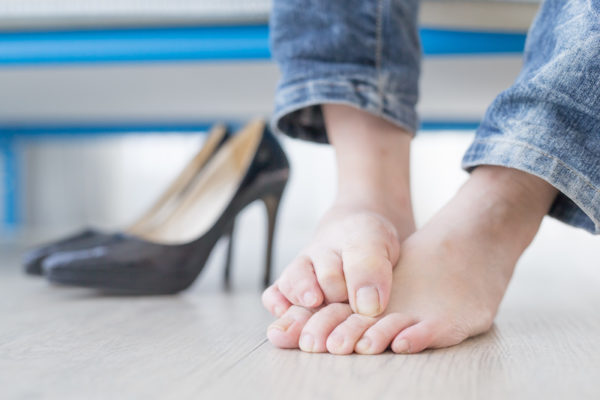
Sore feet? Maybe your shoes aren’t the right size. According to Chris Stanley, a pedorthist at Lamey Wellehan in Auburn, Maine, about 80% of Americans wear shoes that don’t fit correctly. Most of the time, they’re too small. By the way, a pedorthist is someone who is specially trained to fit and modify footwear for people with various foot problems.
Wearing the wrong size shoe isn’t the only possible cause of sore feet. You also want to make sure you’re wearing the right shoe for whatever activity you’re pursuing. “If you’re going hiking, wear a hiking shoe,” says podiatrist Dr. Michael Saraydarian. “If you are going to run, wear a running shoe. The reason we have all these different types of shoes is that they each serve a purpose for a particular activity. Once you make the right shoe choice, then that’s step one.”
Trouble is, it’s not always easy to find the right shoe, especially if you’re shopping online or in a store that may have lots of choices but no dedicated shoe salespeople.
Here are some tips from Chris:
- When looking at new shoes, many people want to have soft, spongy cushions under their feet, but in most cases, that can be detrimental. Having support characteristics in a shoe will actually reduce foot fatigue and increase comfort.
- When shopping for work shoes, shop at a shoe store that measures feet and offers a variety of brands and styles. If the salesperson doesn’t offer to measure your feet and doesn’t bother to review how your shoes fit, then go to a different store.
- The proper shoe, matched with the proper size, often can solve many comfort-related issues.
The next step to loving your feet is to prepare them for whatever they’re going to be doing. “Take time to stretch,” says Chris. “Calf stretches will help to pump blood up out of the foot and generally improve blood circulation. Rolling your foot over a tennis ball or a foot massager will help the intrinsic foot muscles.”
Dr. Saraydarian agrees. “One of the simplest things you can do is roll your foot over a tennis ball,” he says. “It will stretch out all of the structures on the bottom of the foot including the fascia and the muscles and other structures. Then do a simple posterior stretch. I usually suggest one where you stand on a step with half your foot on and the other half off. Keep your knees locked and your buttocks tight and drop the heels down. It will stretch from the gluteus all the way to the heel and you really get all of those posterior structures. Do it for ten seconds ten times. It’s not a huge time investment and it’s easy to do.”
What you’re trying to avoid by wearing the right shoes and doing your stretches is an overuse injury. The most common is plantar fasciitis. It happens when the band of tissue on the bottom of your foot that connects your heel to your toes becomes irritated and inflamed. You can read more about plantar fasciitis in my blog post Why does my heel hurt when I get up in the morning?
Something else you want to be careful about is being on your feet for hours on end. It can be challenging if that’s what your job requires. If you find that your legs hurt as much as your feet at the end of the day, it may be a sign that something else is going on. According to vein specialist Dr. Cindy Asbjornsen at the Vein Healthcare Center, “legs aren’t supposed to hurt, even at the end of a long workday.”
Sore legs after standing all day could be a warning sign of venous disease and should be checked out. Some other signs include bulging veins in the legs, swelling in the legs, and cramps,
Even if we’re just going about our daily activities and aren’t standing all day, we demand a lot of our feet. More than any other part of the body. They deserve a little love.

Leave A Comment